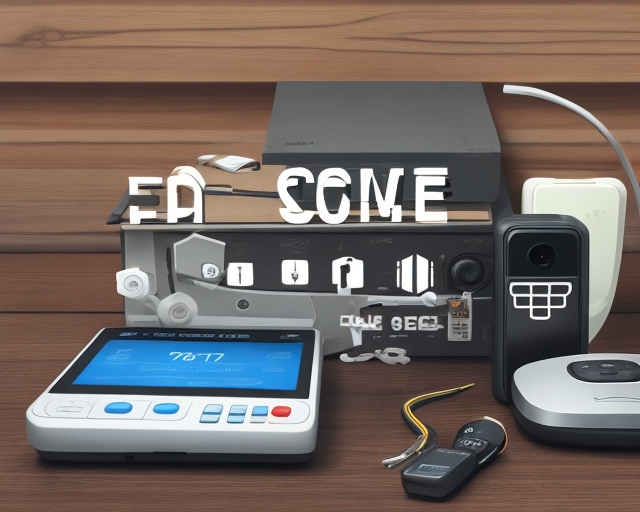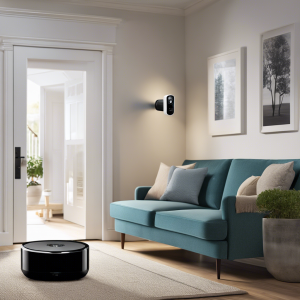In today’s fast-paced world, it is essential to ensure the safety and security of our homes. With the advancement in technology, wireless home security systems have become an increasingly popular choice for homeowners.

But how exactly do these systems work? And more importantly, how can you set up your own wireless home security system without the need for professional installation?
In this guide, we will explore the easy DIY steps to help you achieve a comprehensive wireless home security system that provides peace of mind and protection for you and your loved ones.
So, if you’re ready to take control of your home’s security, let’s dive into the world of wireless home security systems.
Understanding Wireless Home Security Systems
Wireless home security systems are advanced and effective solutions for protecting your home, utilizing cutting-edge technology to provide comprehensive and reliable protection against potential threats. These systems offer several benefits that make them a popular choice among homeowners.
Firstly, wireless security systems are easy to install and set up. Without the need for complex wiring, they can be quickly installed in any corner of the house, making them ideal for both homeowners and renters. Additionally, wireless systems provide flexibility in terms of placement and can be easily moved or expanded as needed. Moreover, they offer remote access and monitoring features, allowing homeowners to control and monitor their security system from anywhere using a smartphone or computer.
Despite the numerous advantages, wireless security systems also have a few drawbacks to consider.
One significant drawback is the potential for signal interference. As wireless systems rely on radio frequency signals, they can be susceptible to interference from other wireless devices or even environmental factors such as thick walls and large metal objects. This interference can affect the system’s reliability and performance.
Furthermore, wireless systems may require regular battery replacements or recharging, which can be inconvenient and add to the overall cost of ownership.
Choosing the Right Wireless Security Cameras
With the understanding of wireless home security systems, the next crucial aspect to consider is selecting the appropriate wireless security cameras for your specific needs and requirements. When it comes to choosing the right wireless security cameras, it is important to consider various factors and features that will enhance your home security system.
Wireless security camera features play a vital role in ensuring effective surveillance and monitoring. One important feature to consider is the camera’s resolution, which determines the clarity and quality of the video footage. Higher resolutions, such as 1080p or 4K, provide clearer images, making it easier to identify faces or objects. Additionally, consider cameras with night vision capabilities that allow for monitoring in low-light or dark conditions.
Another important consideration is the field of view of the camera. The wider the field of view, the more area the camera can cover. This is especially important for outdoor cameras, where a wide field of view can help monitor larger areas and reduce blind spots.
When comparing wireless and wired security cameras, it’s important to consider the advantages of each. Wireless cameras offer flexibility in terms of installation and placement, as they do not require any wiring. They can be easily moved or repositioned as needed. On the other hand, wired cameras provide a more stable and reliable connection, as they are connected directly to the power source and network.
Setting Up a Wireless Home Alarm System
To effectively secure your home, it is essential to properly set up a wireless home alarm system. One of the key components of this system is the wireless alarm sensors. These sensors are responsible for detecting any unauthorized entry or movement within your home. When setting up the wireless alarm sensors, it is important to strategically place them in areas where they can effectively monitor your home’s entry points, such as doors and windows. Additionally, it is crucial to ensure that the sensors are installed securely and that their batteries are regularly checked and replaced to maintain optimal functionality.
Once the wireless alarm sensors are in place, the next step is to configure the mobile app for remote access. This allows you to monitor and control your home alarm system from anywhere using your smartphone or tablet. To configure the mobile app, you will need to follow the instructions provided by the alarm system manufacturer. This typically involves downloading the app, creating an account, and connecting it to your wireless home alarm system. Once configured, you can arm or disarm the system, receive notifications of any alarm events, and even view live video feeds from your security cameras if you have them integrated into your system.
Installing Wireless Motion Sensors
Proper installation of wireless motion sensors is crucial for the effective operation of a home security system. These sensors play a vital role in detecting any movement within their range and triggering an alarm or alert. To ensure optimal performance, it is important to consider the wireless motion sensor range and adjust the motion sensor sensitivity accordingly.
The wireless motion sensor range refers to the maximum distance at which the sensor can detect movement. It is crucial to position the sensors strategically to cover the desired areas while avoiding false alarms caused by objects outside the intended range. By referring to the product specifications and conducting some trial and error, homeowners can determine the ideal placement of the sensors.
Adjusting motion sensor sensitivity is another important aspect of installation. This feature allows users to customize how easily the sensor will be triggered by movement. By adjusting the sensitivity level, homeowners can minimize false alarms caused by pets or other non-threatening objects. It is recommended to start with a moderate sensitivity level and fine-tune it based on the specific needs of the household.
To help you better understand the importance of these factors, here is a table summarizing the wireless motion sensor range and sensitivity adjustment for a few popular home security systems:
| Security System | Wireless Motion Sensor Range | Adjustable Sensitivity |
|---|---|---|
| System A | 30 feet | Yes |
| System B | 50 feet | Yes |
| System C | 100 feet | Yes |
| System D | 150 feet | No |
Securing Your Wi-Fi Network for Enhanced Security
Now that we have explored the crucial aspects of installing wireless motion sensors, it is imperative to address the next crucial step in ensuring comprehensive home security: securing your Wi-Fi network for enhanced security.
Securing your Wi-Fi network is essential to prevent unauthorized access and protect your personal data. One of the key measures to enhance Wi-Fi network security is enabling Wi-Fi network encryption.
Wi-Fi network encryption ensures that the data transmitted between your devices and the router is encrypted, making it difficult for hackers to intercept and decipher the information. The most commonly used encryption protocols are WPA2 (Wi-Fi Protected Access 2) and WPA3, which provide robust security measures.
To enable Wi-Fi network encryption, access your router’s settings by typing its IP address into a web browser and entering the login credentials. Once logged in, navigate to the wireless settings section and select the appropriate encryption protocol. Set a strong encryption password to further enhance the security of your network.
In addition to encryption, proper router password management is crucial. Change the default password provided by the manufacturer to a strong, unique password that includes a combination of letters, numbers, and special characters. Regularly update this password and avoid using common or easily guessable phrases.
Integrating Smart Devices With Your Wireless Security System
Integrating smart devices with your wireless security system allows for seamless automation and enhanced control over your home’s security features. By incorporating smart device compatibility into your wireless security system, you can take advantage of numerous benefits that significantly improve the overall security of your home.
Here are some of the benefits of integrating smart devices with your wireless security system:
-
Improved convenience: With smart devices, you can remotely control and monitor your security system using your smartphone or tablet. This allows you to arm or disarm your system, receive real-time alerts, and even view live video feeds from your security cameras, all from the convenience of your fingertips.
-
Enhanced automation: Smart devices enable automation features that can integrate with your security system. For example, you can schedule your lights to turn on and off while you’re away to give the impression that someone is home, deterring potential intruders.
-
Integration with other smart home devices: Integrating your wireless security system with other smart devices in your home, such as smart locks or motion sensors, allows for a more comprehensive security solution. These devices can work together to provide a seamless and robust security system.
Monitoring Your Wireless Home Security System Remotely
Monitoring your wireless home security system remotely is a crucial aspect of ensuring the effectiveness and reliability of your home’s security measures. With remote access and mobile app integration, you can stay connected to your home security system from anywhere and at any time.
Remote access allows you to monitor your security system and receive real-time alerts on your mobile device or computer. Whether you are at work, on vacation, or simply away from home, you can keep an eye on your property and respond quickly to any potential security threats.
Through mobile app integration, you can conveniently control and manage your wireless home security system using your smartphone or tablet. This means you can arm and disarm your system, view live video feeds from your security cameras, and adjust settings, all with just a few taps on your mobile device.
Furthermore, mobile app integration enables you to customize your security system settings based on your preferences and needs. You can set up specific alerts and notifications, manage user access and permissions, and even integrate other smart devices into your home security system for enhanced functionality.
Troubleshooting Common Issues With Wireless Security Systems
To ensure the smooth operation of your wireless home security system, it is essential to address and resolve common issues that may arise. Troubleshooting connectivity problems and resolving false alarms are two key areas to focus on when troubleshooting wireless security systems.
When it comes to troubleshooting connectivity, it is crucial to check the signal strength between the sensors and the control panel. Weak or intermittent signals can lead to connectivity issues. Ensure that the sensors are within the recommended range and not obstructed by walls or other objects. Additionally, check for any interference from other wireless devices in the vicinity. Adjusting the placement of the control panel or adding signal repeaters can help improve connectivity.
Resolving false alarms is another common issue with wireless security systems. False alarms can be triggered by various factors such as pets, insects, or even environmental conditions like drafts. To address this, consider adjusting the sensitivity settings on the sensors or installing pet-immune sensors. Regularly clean and maintain the sensors to prevent false alarms caused by dust or debris.
Frequently Asked Questions
How Long Does the Battery Life Typically Last for Wireless Security Cameras?
The battery life of wireless security cameras typically varies depending on factors such as camera model, usage, and battery capacity. It is important to choose cameras with longer battery life to ensure continuous surveillance and minimize the need for frequent battery replacements.
Can I Use My Existing Wi-Fi Network for a Wireless Home Alarm System?
Yes, it is possible to use your existing Wi-Fi network for a wireless home alarm system. This option allows for easy installation and integration with other smart home devices. However, professional installation offers additional benefits such as expertise and customization.
Are Wireless Motion Sensors More Prone to False Alarms Compared to Wired Ones?
Wireless motion sensors may be more prone to false alarms compared to wired ones due to factors such as interference or sensitivity adjustments. However, false alarm prevention techniques, such as adjusting sensitivity levels or using advanced algorithms, can help mitigate this issue.
Is It Possible to Integrate a Smart Doorbell With a Wireless Security System?
Yes, it is possible to integrate a smart doorbell with a wireless security system. This integration offers several benefits, such as real-time notifications, two-way communication, and the ability to remotely view and control the doorbell’s camera feed.
How Often Should I Change the Password for My Wi-Fi Network to Ensure Maximum Security?
Changing passwords regularly is considered one of the best practices for securing Wi-Fi networks. It is recommended to change the password at least every 3 months to ensure maximum security and prevent unauthorized access.
Wireless home security systems offer a convenient and reliable solution for protecting your home. By understanding the different components and features of these systems, such as wireless security cameras, alarm systems, motion sensors, and Wi-Fi network security, you can enhance the overall security of your home.
Additionally, integrating smart devices allows for seamless automation and remote monitoring of your security system. By troubleshooting common issues that may arise, you can ensure the continued effectiveness of your wireless home security system.



